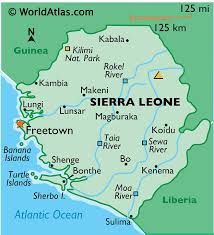By: Hassan Osman Kargbo
Sierra Leone faces one of the gravest climate challenges in the world, with a new World Bank report warning that climate change could derail the country’s fragile progress and plunge millions deeper into poverty if urgent reforms are not adopted.
The World Bank’s Sierra Leone Country Climate and Development Report (CCDR), released mid-year 2025, describes climate change not merely as an environmental issue but as the single most decisive factor shaping Sierra Leone’s development trajectory. The findings position the country as among the most climate-exposed economies globally, with shocks to agriculture, infrastructure, and human development threatening to erode hard-won economic gains.
According to the Notre Dame Global Adaptation Index, Sierra Leone ranks 151st out of 181 countries in readiness to respond to climate threats. This low standing reflects the country’s limited adaptive capacity and high vulnerability. Recent history has repeatedly underscored these weaknesses: the devastating Freetown mudslides of 2017, recurring floods that displace thousands annually, and unpredictable farming seasons that worsen food insecurity.
The report highlights that Sierra Leone’s GDP per capita was already among the hardest hit globally between 1991 and 2010 due to climate shocks. Without decisive reforms, climate change could slash economic growth by 9 to 10 percent by 2050.
Rising temperatures form a central challenge. Projections suggest that average annual temperatures could rise from 26.5°C today to nearly 28°C by mid-century under pessimistic scenarios. Such shifts are expected to disrupt rainfall patterns, trigger droughts, and intensify flooding, complicating planning for agriculture, health, and infrastructure. Rainfall in Sierra Leone is already among the heaviest in the world, averaging more than 2,650 millimetres annually. Increasing variability is expected, with prolonged dry spells alternating with extreme downpours that could devastate farmland, erode soils, and trigger further landslides.
This instability feeds directly into Sierra Leone’s structural economic weaknesses. Agriculture, though reduced from its historic dominance, still contributes around 30 percent of GDP and employs nearly half the population. Any shock to farming directly undermines household incomes and food security. Crops such as rice and cassava are particularly vulnerable to rainfall variability.
The social consequences are equally severe. Over half of Sierra Leone’s population remains in poverty, and climate shocks are projected to push hundreds of thousands more into extreme hardship by mid-century if left unaddressed. Urban centers, particularly Freetown, are increasingly at risk, as rapid population growth and unplanned settlements leave communities exposed to floods and landslides.
Macroeconomic stability is also at stake. Climate-induced disasters impose high recovery costs. The 2017 landslide inflicted $31 million in damages and required $82 million for recovery—nearly 1 percent of GDP at the time. The World Bank warns that future events could carry far heavier economic tolls without resilience investment.
To avert disaster, the CCDR sets out urgent strategies across agriculture, energy, infrastructure, and human capital. It calls for climate-smart agriculture through irrigation, resilient seed varieties, and sustainable land management. A transition toward renewable energy is presented as essential, both to reduce dependence on imported fuels and to drive greener economic growth. The report stresses the need for climate-proof infrastructure, including roads, schools, and health facilities, especially in flood-prone districts. Freetown and other urban centres require stronger planning, zoning enforcement, and early-warning systems.
Equally crucial is investment in human capital. Strengthening education and healthcare would help communities better adapt to shocks. None of these reforms, however, can be realized without adequate financing. The report emphasizes mobilizing domestic revenue, attracting international climate finance, and creating incentives for private sector participation.
What distinguishes this report from earlier assessments is the direct link it draws between climate resilience and Sierra Leone’s economic future. It argues that with ambitious reforms, the country could still reach lower-middle-income status by 2032. The alternative, it warns, is a future defined by entrenched poverty, instability, and the crippling costs of climate disasters.
The message is clear: Sierra Leone’s vulnerabilities are undeniable, but its fate is not sealed. With bold policy choices, stronger institutions, and investment in resilience, the nation can transform climate risks into opportunities for inclusive, sustainable growth. But the window of opportunity is closing rapidly. Each hotter day, each heavier rainfall, and each missed reform compounds the crisis.
The real question is no longer whether Sierra Leone should act, but whether it can act quickly enough to safeguard its future.













